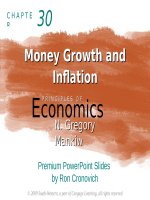- Trang chủ >>
- Mẫu Slide >>
- Văn Bản - Text
princ ch30 presentation
Bạn đang xem bản rút gọn của tài liệu. Xem và tải ngay bản đầy đủ của tài liệu tại đây (114.98 KB, 33 trang )
30
Money Growth and Inflation
In this chapter, look for the answers to
these questions:
How does the money supply affect inflation and
nominal interest rates?
Does the money supply affect real variables like
real GDP or the real interest rate?
How is inflation like a tax?
What are the costs of inflation? How serious
are they?
2
Introduction
This chapter introduces the quantity theory of
money to explain one of the Ten Principles of
Economics from Chapter 1:
Prices rise when the govt prints
too much money.
Most economists believe the quantity theory
is a good explanation of the long run behavior
of inflation.
3
The Value of Money
P = the price level
(e.g., the CPI or GDP deflator)
P is the price of a basket of goods, measured in
money.
1/P is the value of $1, measured in goods.
Example: basket contains one candy bar.
• If P = $2, value of $1 is 1/2 candy bar
• If P = $3, value of $1 is 1/3 candy bar
Inflation drives up prices, and drives down the
value of money.
4
Money Supply (MS)
In real world, determined by Federal Reserve,
the banking system, consumers.
In this model, we assume the Fed precisely
controls MS and sets it at some fixed amount.
5
Money Demand (MD)
Refers to how much wealth people want to hold in
liquid form.
Depends on P:
An increase in P reduces the value of money,
so more money is required to buy goods & services.
Thus, quantity of money demanded
is negatively related to the value of money
and positively related to P, other things equal.
(These “other things” include real income, interest
rates, availability of ATMs.)
6
The Money Supply-Money Demand
Diagram
Value of
Money, 1/P
1
Price
Level, P
As the value of
money rises, the
price level falls.
1
ắ
1.33
ẵ
2
ẳ
4
Quantity
of Money
7
The Money Supply-Demand Diagram
Value of
Money, 1/P
Price
Level, P
MS1
1
1
ắ
1.33
ẵ
ẳ
The Fed sets MS
at some fixed value,
regardless of P.
$1000
2
4
Quantity
of Money
8
The Money Supply-Demand Diagram
Value of
Money, 1/P
1
A fall in value of money
(or increase in P)
increases the quantity
of money demanded:
Price
Level, P
1
ắ
1.33
ẵ
2
ẳ
4
MD1
Quantity
of Money
9
The Money Supply-Demand Diagram
Value of
Money, 1/P
MS1
1
eq’m
value
of
money
P adjusts to equate
quantity of money
demanded with
money supply.
1
1.33
ắ
ẵ
Price
Level, P
A
ẳ
2
MD1
$1000
eqm
price
level
4
Quantity
of Money
10
The Effects of a Monetary Injection
Value of
Money, 1/P
MS1
MS2
1 Fed
Suppose the
increases the
money supply.
ắ
eqm
value
of
money
ẵ
Price
Level, P
1
Then the value
of money falls,
and P rises.
1.33
A
2
B
ẳ
MD1
$1000
$2000
4
eqm
price
level
Quantity
of Money
11
A Brief Look at the Adjustment
Process
Result from graph: Increasing MS causes P to rise.
How does this work? Short version:
•
At the initial P, an increase in MS causes
excess supply of money.
•
People get rid of their excess money by spending it
on goods & services or by loaning it to others, who
spend it. Result: increased demand for goods.
•
But supply of goods does not increase,
so prices must rise.
(Other things happen in the short run, which we will
study in later chapters.)
12
Real vs. Nominal Variables
Nominal variables are measured in monetary
units.
examples: nominal GDP,
nominal interest rate (rate of return measured in $)
nominal wage ($ per hour worked)
Real variables are measured in physical units.
examples: real GDP,
real interest rate (measured in output)
real wage (measured in output)
13
Real vs. Nominal Variables
Prices are normally measured in terms of money.
• Price of a compact disc:
• Price of a pepperoni pizza:
$15/cd
$10/pizza
A relative price is the price of one good relative to
(divided by) another:
• Relative price of CDs in terms of pizza:
$15/cd
price of cd
= 1.5 pizzas per cd
=
$10/pizza
price of pizza
Relative prices are measured in physical units,
so they are real variables.
14
Real vs. Nominal Wage
An important relative price is the real wage:
W = nominal wage = price of labor, e.g., $15/hour
P = price level = price of g&s, e.g., $5/unit of output
Real wage is the price of labor relative to the price
of output:
$15/hour
W
= 3 units output per hour
=
$5/unit of output
P
15
The Classical Dichotomy
Classical dichotomy: the theoretical separation
of nominal and real variables
Hume and the classical economists
suggested that monetary developments
affect nominal variables, but not real variables.
If central bank doubles the money supply,
Hume & classical thinkers contend
• all nominal variables – including prices –
will double.
• all real variables – including relative prices –
will remain unchanged.
16
The Neutrality of Money
Monetary neutrality: the proposition that changes
in the money supply do not affect real variables
Doubling money supply causes all nominal prices
to double; what happens to relative prices?
Initially, relative price of cd in terms of pizza is
$15/cd
= 1.5 pizzas per cd
=
$10/pizza
The relative price
After nominal prices double,
is unchanged.
$30/cd
price of cd
= 1.5 pizzas per cd
=
$20/pizza
price of pizza
price of cd
price of pizza
17
The Neutrality of Money
Monetary neutrality: the proposition that changes
in the money supply do not affect real variables
Similarly, the real wage W/P remains unchanged, so
•
•
•
quantity of labor supplied does not change
quantity of labor demanded does not change
total employment of labor does not change
The same applies to employment of capital and
other resources.
Since employment of all resources is unchanged,
total output is also unchanged by the money supply.
18
The Neutrality of Money
Most economists believe the classical dichotomy
and neutrality of money describe the economy in
the long run.
In later chapters, we will see that monetary
changes can have important short-run effects
on real variables.
19
The Velocity of Money
Velocity of money: the rate at which money
changes hands
Notation:
P x Y = nominal GDP
= (price level) x (real GDP)
M
= money supply
V
= velocity
Velocity formula:
PxY
V =
M
20
The Velocity of Money
PxY
Velocity formula: V =
M
Example with one good: pizza.
In 2006,
Y
= real GDP = 3000 pizzas
P
= price level = price of pizza = $10
P x Y = nominal GDP = value of pizzas = $30,000
M
= money supply = $10,000
V
= velocity = $30,000/$10,000 = 3
The average dollar was used in 3 transactions.
21
The Quantity Equation
Velocity formula:
PxY
V =
M
Multiply both sides of formula by M:
MxV = PxY
Called the quantity equation
22
The Quantity Theory in 5 Steps
Start with quantity equation: M x V = P x Y
1. V is stable.
2. So, a change in M causes nominal GDP (P x Y)
to change by the same percentage.
3. A change in M does not affect Y:
money is neutral,
Y is determined by technology & resources
4. So, P changes by same percentage as
P x Y and M.
5. Rapid money supply growth causes rapid inflation.
23
The Inflation Tax
When tax revenue is inadequate and ability to
borrow is limited, govt may print money to pay
for its spending.
Almost all hyperinflations start this way.
The revenue from printing money is the
inflation tax: printing money causes inflation,
which is like a tax on everyone who holds
money.
In the U.S., the inflation tax today accounts for
less than 3% of total revenue.
24
The Fisher Effect
Rearrange the definition of the real interest rate:
nominal
real interest
inflation
+
=
interest rate
rate
rate
The real interest rate is determined by saving &
investment in the loanable funds market.
Money supply growth determines inflation rate.
So, this equation shows how the nominal interest
rate is determined.
25









